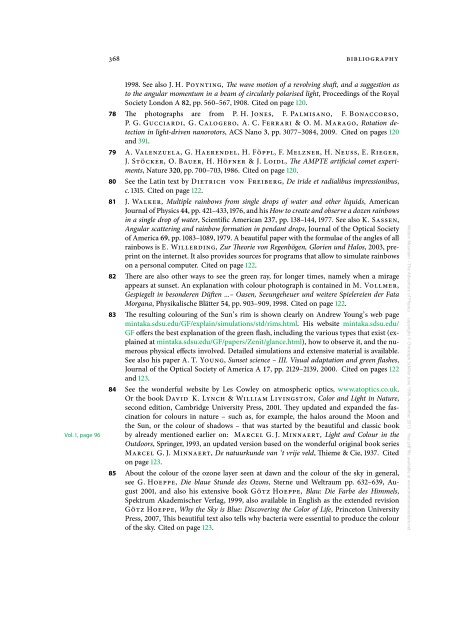MOTION MOUNTAIN
LIGHT, CHARGES AND BRAINS - Motion Mountain
LIGHT, CHARGES AND BRAINS - Motion Mountain
You also want an ePaper? Increase the reach of your titles
YUMPU automatically turns print PDFs into web optimized ePapers that Google loves.
368 bibliography<br />
Vol. I, page 96<br />
1998. See also J. H. Poynting, The wave motion of a revolving shaft, and a suggestion as<br />
to the angular momentum in a beam of circularly polarised light, Proceedings of the Royal<br />
Society London A82, pp. 560–567, 1908. Cited on page 120.<br />
78 The photographs are from P. H. Jones, F. Palmisano, F. Bonaccorso,<br />
P. G. Gucciardi, G. Calogero, A. C. Ferrari & O. M. Marago, Rotation detection<br />
in light-driven nanorotors, ACS Nano 3, pp. 3077–3084, 2009. Cited on pages 120<br />
and 391.<br />
79 A. Valenzuela, G. Haerendel, H. Föppl, F. Melzner, H. Neuss, E. Rieger,<br />
J. Stöcker, O. Bauer, H. Höfner & J. Loidl, The AMPTE artificial comet experiments,<br />
Nature320, pp. 700–703, 1986. Cited on page 120.<br />
80 See the Latin text by Dietrich von Freiberg, De iride et radialibus impressionibus,<br />
c. 1315. Cited on page 122.<br />
81 J. Walker, Multiple rainbows from single drops of water and other liquids, American<br />
Journal of Physics44, pp. 421–433, 1976, and hisHowtocreateandobserveadozenrainbows<br />
in a single drop of water, Scientific American 237, pp. 138–144, 1977. See also K. Sassen,<br />
Angular scattering and rainbowformation in pendant drops, Journal of the Optical Society<br />
of America69, pp. 1083–1089, 1979. A beautiful paper with the formulae of the angles of all<br />
rainbows is E. Willerding, Zur Theorie von Regenbögen, Glorien und Halos, 2003, preprint<br />
on the internet. It also provides sources for programs that allow to simulate rainbows<br />
on a personal computer. Cited on page 122.<br />
82 There are also other ways to see the green ray, for longer times, namely when a mirage<br />
appears at sunset. An explanation with colour photograph is contained in M. Vollmer,<br />
Gespiegelt in besonderen Düften ...– Oasen, Seeungeheuer und weitere Spielereien der Fata<br />
Morgana, Physikalische Blätter54, pp. 903–909, 1998. Cited on page 122.<br />
83 The resulting colouring of the Sun’s rim is shown clearly on Andrew Young’s web page<br />
mintaka.sdsu.edu/GF/explain/simulations/std/rims.html. His website mintaka.sdsu.edu/<br />
GF offers the best explanation of the green flash, including the various types that exist (explained<br />
at mintaka.sdsu.edu/GF/papers/Zenit/glance.html), how to observe it, and the numerous<br />
physical effects involved. Detailed simulations and extensive material is available.<br />
See also his paper A. T. Young, Sunset science – III. Visual adaptation and green flashes,<br />
Journal of the Optical Society of America A 17, pp. 2129–2139, 2000. Cited on pages 122<br />
and 123.<br />
84 See the wonderful website by Les Cowley on atmospheric optics, www.atoptics.co.uk.<br />
Or the book David K. Lynch & William Livingston, Color and Light in Nature,<br />
second edition, Cambridge University Press, 2001. They updated and expanded the fascination<br />
for colours in nature – such as, for example, the halos around the Moon and<br />
the Sun, or the colour of shadows – that was started by the beautiful and classic book<br />
by already mentioned earlier on: Marcel G. J. Minnaert, Light and Colour in the<br />
Outdoors, Springer, 1993, an updated version based on the wonderful original book series<br />
Marcel G. J. Minnaert, De natuurkunde van ‘t vrije veld, Thieme & Cie, 1937. Cited<br />
on page 123.<br />
85 About the colour of the ozone layer seen at dawn and the colour of the sky in general,<br />
see G. Hoeppe, Die blaue Stunde des Ozons, Sterne und Weltraum pp. 632–639, August<br />
2001, and also his extensive book Götz Hoeppe, Blau: Die Farbe des Himmels,<br />
Spektrum Akademischer Verlag, 1999, also available in English as the extended revision<br />
Götz Hoeppe, Why the Sky is Blue: Discovering the Color of Life, Princeton University<br />
Press, 2007,This beautiful text also tells why bacteria were essential to produce the colour<br />
of the sky. Cited on page 123.<br />
Motion Mountain – The Adventure of Physics copyright © Christoph Schiller June 1990–November 2015 free pdf file available at www.motionmountain.net







